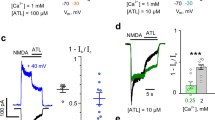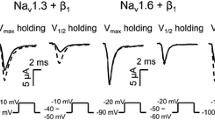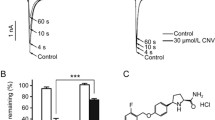Abstract
Antidepressants, such as traditional tricyclic antidepressants (TCAs), are the first-line treatment for various pain syndromes. Available evidence indicates that TCAs may target Na+ channels for their analgesic action. In this report, we examined the effects of contemporary antidepressants sertraline and paroxetine on (1) neuronal Na+ channels expressed in GH3 cells and (2) muscle rNav1.4 Na+ channels heterologously expressed in Hek293t cells. Our results showed that both antidepressants blocked Na+ channels in a highly state-dependent manner. The 50% inhibitory concentrations (IC50) for sertraline and paroxetine ranged ∼18–28 μm for resting block and ∼2–8 μm for inactivated block of neuronal and rNav1.4 Na+ channels. Surprisingly, the IC50 values for both drugs were about 0.6–0.7 μm for the open channel block of persistent late Na+ currents generated through inactivation-deficient rNav1.4 mutant Na+ channels. For comparison, the open channel block in neuronal hNav1.7 counterparts yielded IC50 values around 0.3–0.4 μm for both drugs. Receptor mapping using fast inactivation-deficient rNav1.4-F1579A/K mutants with reduced affinities toward local anesthetics (LAs) and TCAs indicated that the F1579 residue is not involved in the binding of sertraline and paroxetine. Thus, sertraline and paroxetine are potent open channel blockers that target persistent late Na+ currents preferentially, but their block is not mediated via the phenylalanine residue at the known LA/TCA receptor site.










Similar content being viewed by others
References
Aldrich RW, Corey DP, Stevens CF (1983) A reinterpretation of mammalian sodium channel gating based on single channel recording. Nature 306:436–441
Ansari A (2000) The efficacy of newer antidepressants in the treatment of chronic pain: a review of current literature. Harv Rev Psychiatry 7:257–277
Baldessarini RJ (2001) Drugs and the treatment of psychiatric disorders: depression and anxiety disorders. In: Hardman JG, Limbird LE, Gilman AG (eds) The pharmacological basis of therapeutics. McGraw-Hill, New York, pp 447–484
Brau ME, Dreimann M, Olschewski A, Vogel W, Hempelmann G (2001) Effects of drugs used for neuropathic pain management on tetradotoxin-resistant Na+ currents in rat sensory neurons. Anesthesiology 94:137–144
Catterall WA (2000) From ionic currents to molecular mechanisms: the structure and function of voltage-gated sodium channels. Neuron 26:13–25
Catterall WA, Mackie K (2001) Local anesthetics. In: Hardman JG, Limbird LE, Molinoff PB, Ruddon RW, Gilman AG (eds) Goodman & Gilman’s The pharmacological basis of therapeutics. Macmillan, New York, pp 367–384
Cota G, Armstrong CM (1989) Sodium channel gating in clonal pituitary cells: the inactivation step is not voltage dependent. J Gen Physiol 94:213–232
Devor M, Seltzer Z (1999) Pathophysiology of damaged nerves in relation to chronic pain. In: Wall PD, Melzack R (eds) Textbook of pain. Churchill Livingstone, New York, pp 129–164
Dick IE, Brochu RM, Purohit Y, Kaczorowski GJ, Martin WJ, Priest BT (2006) Sodium channel blockade may contribute to the analgesic efficacy of antidepressants. J Pain 8:315–324
Doran A, Obach RS, Smith BJ, Hosea NA, Becker S, Callegari E, Chen C, Chen X, Choo E, Cianfrogna J, Cox LM, Gibbs JP, Gibbs MA, Hatch H, Hop CE, Kasman IN, Laperle J, Liu J, Liu X, Logman M, Maclin D, Nedza FM, Nelson F, Olson E, Rahematpura S, Raunig D, Rogers S, Schmidt K, Spracklin DK, Szewc M, Troutman M, Tseng E, Tu M, Van Deusen JW, Venkatakrishnan K, Walens G, Wang EQ, Wong D, Yasgar AS, Zhang C (2005) The impact of P-glycoprotein on the disposition of drugs targeted for indications of the central nervous system: evaluation using the MDR1A/1B knockout mouse model. Drug Metab Dispos 33:165–174
Gerner P, Wang GK (2006) Mechanisms of tricyclic antidepressants in pain modulation. In: Mao J (ed) Comparing preclinical studies and clinical pain management: lost in translation? Nova Science Publishers, Hauppauge, NY, pp 189–206
Gonzalez-Viejo MA, Avellanet M, Hernandez-Morcuende MI (2005) A comparative study of fibromyalgia treatment: ultrasonography and physiotherapy versus sertraline treatment. Ann Readapt Med Phys 48:610–615
Grant AO, Chandra R, Keller C, Carboni M, Starmer CF (2000) Block of wild-type and inactivation-deficient cardiac sodium channels IFM/QQQ stably expressed in mammalian cells. Biophys J 79:3019–3035
Hamill OP, Marty E, Neher ME, Sakmann B, Sigworth FJ (1981) Improved patch-clamp techniques for high-resolution current recording from cells and cell-free membrane patches. Pfluegers Arch 391:85–100
Huang CJ, Harootunian A, Maher MP, Quan C, Raj CD, McCormack K, Numann R, Negulescu PA, Gonzalez JE (2006) Characterization of voltage-gated sodium-channel blockers by electrical stimulation and fluorescence detection of membrane potential. Nat Biotechnol 24:439–446
Klugbauer N, Lacinova L, Flockerzi V, Hofmann F (1995) Structure and functional expression of a new member of the tetrodotoxin-sensitive voltage-activated sodium channel family from human neuroendocrine cells. EMBO J 14:1084–1090
Masand PS, Narasimhan M, Patlak J (2006) Paroxetine for somatic pain associated with physical illness: a review. Prim Care Companion J Clin Psychiatry 8:122–130
Monks R, Merskey H (1999) Psychotropic drugs. In: Wall PD, Melzack R (eds) Textbook of pain. Churchill Livingstone, New York, pp 1155–1186
Nassar MA, Stirling LC, Forlani G, Baker MD, Matthews EA, Dickenson AH, Wood JN (2004) Nociceptor-specific gene deletion reveals a major role for Nav1.7 (PN1) in acute and inflammatory pain. Proc Natl Acad Sci USA 101:12706–12711
Nau C, Wang GK (2004) Interactions of local anesthetics with voltage-gated Na+ channels. J Membr Biol 201:1–8
Pancrazio JJ, Kamatchi GL, Roscoe AK, Lynch C (1998) Inhibition of neuronal Na+ channels by antidepressant drugs. J Pharmacol Exp Ther 284:208–214
Ramos E, O’Leary ME (2004) State-dependent trapping of flecainide in the cardiac sodium channel. J Physiol 560:37–49
Sawynok J (2003) Topical and peripherally acting analgesics. Pharmacol Rev 55:1–20
Vega AV, Espinaosa JL, Lopez-Dominguez AM, Lopez-Santiago LF, Navarrete A, Cota G (2003) L-type calcium channel activation up-regulates the mRNAs for two different sodium channel alpha subunits (Nav1.2 and Nav1.3) in rat pituitary GH3 cells. Brain Res Mol Brain Res 116:115–125
Wang GK, Russell C, Wang SY (2003a) State-dependent block of wild-type and inactivation-deficient Na+ channels by flecainide. J Gen Physiol 122:365–374
Wang S-Y, Bonner K, Russell C, Wang GK (2003b) Tryptophan scanning of D1S6 and D4S6 C-termini in voltage-gated sodium channels. Biophys J 85:911–920
Wang GK, Russell C, Wang S-Y (2004a) State-dependent block of voltage-gated Na+ channels by amitriptyline via the local anesthetic receptor and its implication for neuropathic pain. Pain 110:166–174
Wang S-Y, Mitchell J, Moczydlowski E, Wang GK (2004b) Block of inactivation-deficient Na+ channels by local anesthetics in stably transfected mammalian cells: evidence for drug binding along the activation pathway. J Gen Physiol 124:691–701
Wood JN, Boorman JP, Okuse K, Baker MD (2004) Voltage-gated sodium channels and pain pathways. J Neurobiol 61:55–71
Wright SN, Wang SY, Xiao YF, Wang GK (1999) State-dependent cocaine block of sodium channel isoforms, chimeras, and channels coexpressed with the beta1 subunit. Biophys J 76:233–245
Zhou Y, MacKinnon R (2004) Ion binding affinity in the cavity of the KcsA potassium channel. Biochemistry 43:4978–4982
Acknowledgements
This work was supported by a grant from the National Institutes of Health (GM48090). We are grateful to Dr. Edward Moczydlowski for the HEK293 cell line expressing wild-type rNav1.4 channels and Dr. Norbert Klugbauer for the hNav1.7 clone.
Author information
Authors and Affiliations
Corresponding author
Rights and permissions
About this article
Cite this article
Wang, G.K., Mitchell, J. & Wang, SY. Block of Persistent Late Na+ Currents by Antidepressant Sertraline and Paroxetine. J Membrane Biol 222, 79–90 (2008). https://doi.org/10.1007/s00232-008-9103-y
Received:
Accepted:
Published:
Issue Date:
DOI: https://doi.org/10.1007/s00232-008-9103-y




